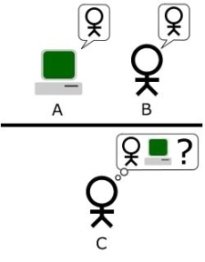|
| ||
|
| ||
What is a Turing Test?The Turing Test is named after British mathematician Alan Mathison Turing who is often considered to be the father of modern computer science. In 1950 Turing published an article titled Computing Machinery and Intelligence where he introduced what he believed to be a practical test for assessing computer intelligence. 
The Turing test is an interactive test involving three participants - a computer, a human interrogator and a human participant. It is a blind test where the interrogator asks questions via keyboard and receives answers via display screen on the basis of which he or she has to determine which answers come from the computer and which from the human subject. According to Alan Turing if a statistically sufficient number of different people play the roles of interrogator and human subject, and, if a sufficient proportion of the interrogators are unable to distinguish the computer from the human being, then the computer is considered an intelligent, thinking entity or AI. There are a number of issues with the Turing Test. Some of the main are: Is it possible to create a practical test to assess when computers attain artificial intelligence? How do we treat those entities who pass such an AI test? Do you want to sumbit your own singularity content?Do you agree or disagree with the content of this page? Do you want to improve it? Do you want to post some great singularity content of your own? Why not share it here at Singularity Symposium?! |
|
|
|
| ||
Internet gems
| ||
|
Copyright © 2012 - www.SingularitySymposium.com - All Rights Reserved
| ||




